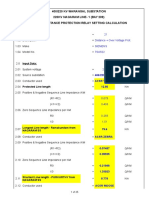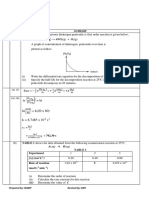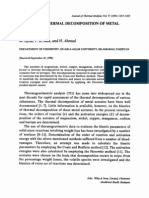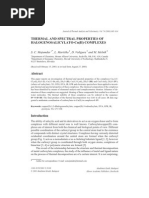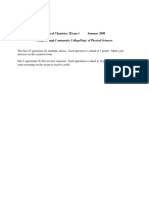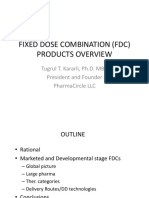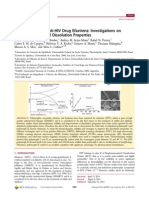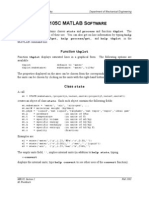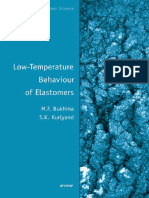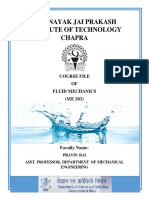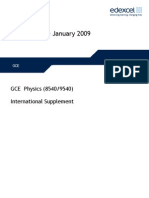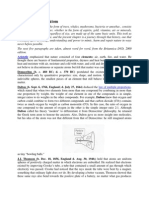Silva 2004
Silva 2004
Uploaded by
Paulo DantasCopyright:
Available Formats
Silva 2004
Silva 2004
Uploaded by
Paulo DantasOriginal Description:
Copyright
Available Formats
Share this document
Did you find this document useful?
Is this content inappropriate?
Copyright:
Available Formats
Silva 2004
Silva 2004
Uploaded by
Paulo DantasCopyright:
Available Formats
Journal of Thermal Analysis and Calorimetry, Vol.
75 (2004) 583–590
KINETIC AND THERMODYNAMIC PARAMETERS OF
THE THERMAL DECOMPOSITION OF ZINC(II)
DIALKYLDITHIOCARBAMATE COMPLEXES
Marta C. D. Silva1*, Marta M. Conceição1, Maria F. S. Trindade1,
A. G. Souza1, C. D. Pinheiro1, J. C. Machado2 and P. F. A. Filho3
1
Departamento de Química, CCEN, Universidade Federal da Paraíba, 58059-900 João Pessoa, Paraíba,
Brazil
2
Departamento de Química, ICEx, Universidade Federal de Minas Gerais, 31270-901 Belo Horizonte,
MG, Brazil
3
Departamento Ciências Básicas Sociais, Campus IV, Universidade Federal da Paraíba, Bananeiras,
PB, Brazil
Abstract
The thermodynamic and kinetic parameters of the thermal decomposition of Zn(S2CNR2)2 com-
plexes (R=CH3, C2H5 and n-C3H7) were determined with the dynamic thermogravimetric method.
Superimposed TG/DTG/DSC curves show that thermal decomposition reactions for chelates with
R=C 2H5 and n-C3H7 occur in the liquid phase, at temperatures far away from their melting points,
whereas for the complex with R=CH3 the thermal decomposition begins at a temperature closer to its
melting point, suggesting a rather complex decomposition mechanism.
Keywords: dithiocarbamates, thermal decomposition, zinc
Introduction
The thermal decomposition mechanism of solid dialkyldithiocarbamates [M(CS2CNR2)n;
M=metal] shows a particular behavior: differently from most solid metal complexes that
decompose in the solid phase, metal dialkyldithiocarbamates decompose in the liquid
phase at temperatures far away from their melting points [1–3].
In the present work the kinetic and thermodynamic parameters for the thermal
decomposition of Zn[S2CN(CH3)2]2, Zn[S2CN(C2H5)2]2 and Zn[S2CN(n-C3H7)2]2
were determined using a non-isothermal method.
* Author for correspondence: E–mail: martacelia@yahoo.com
1388–6150/2004/ $ 20.00 Akadémiai Kiadó, Budapest
© 2004 Akadémiai Kiadó, Budapest Kluwer Academic Publishers, Dordrecht
584 SILVA et al.: ZINC(II) DIALKYLDITHIOCARBAMATE COMPLEXES
Experimental
Zn(II) dialkyldithiocarbamate complexes were synthesized from direct reaction of
ZnCl2 with appropriated dialkylammonium compounds in acetone, as described in
more detail elsewhere [4–7].
After purification, the complexes were vacuum dried and characterized by dif-
ferent techniques, such as melting point determination, thermal analysis (TG, DTG
and DSC), infrared spectroscopy, mass spectroscopy and elemental analysis.
The melting points were obtained with a Microquimica equipment model
MQAPF 301 and a differential scanning calorimeter Shimadzu-model DSC-50. The
infrared spectra, in the 4000–400 cm–1 region, were obtained with a Bomem spec-
trometer, model MB-102; samples were mixed with KBr and pressed to form pellets.
Mass spectra were obtained with a Varian (model MAT 311) spectrometer, at ioniza-
tion energy of 70 eV. The elemental analysis for C, H and N were performed with a
Perkin Elmer CHN analyzer, model PE 2400.
The dynamic thermogravimetric curves were obtained in a Shimadzu Thermo-
balance model TGA-50, under nitrogen atmosphere, at 50 mL min–1 carrier gas flow
and initial sample masses 5.0±0.7 mg, in the range of 25–500°C, with heating rates of
5, 10 and 15°C min–1.
Results and discussion
Characterization of complexes
The melting temperature values obtained either by the conventional method or by
DSC determination were rather similar (Table 1).
Table 1 Melting points obtained by conventional and DSC measurements
Melting temperatures/°C
Complexes
Conventional method DSC
Zn[S2CN(CH3)2]2 252.7–253.0 253.4
Zn[S2CN(C2H5)2]2 178.8–180.6 180.6
Zn[S2CN(n-C3H7)2]2 113.5–115.5 114.5
As summarized in Table 2, infrared spectra show typical bands of a complex forma-
tion, particularly due to the presence of strong stretching ν(C–N) vibration bands in the
range 1480–1550 cm–1, similarly to those observed for a number of dithiocarbamate
complexes [8, 9]. In addition, the lower wavenumber for the ν(C–S) stretching band and
an isolated band near 1000 cm–1 indicate that the ligand is bidentately bound to the metal.
J. Therm. Anal. Cal., 75, 2004
SILVA et al.: ZINC(II) DIALKYLDITHIOCARBAMATE COMPLEXES 585
Table 2 Principal absorption bands observed in the infrared spectra
Attribution
Complexes
C=N N–C=S =C–S C–S
Zn[S2CN(CH3)2]2 1522.6(s) 1242.8(s) 1050.4(w) 973.2(s)
Zn[S2CN(C2H5)2]2 1503.0(s) 1272.2(s) 1073.0(s) 994.0(s)
Zn[S2CN(n-C3H7)2]2 1498.0(s) 1241.1(s) 1088.6(m) 974.6(m)
s=strong; m=medium; w=weak
Table 3 Elemental analysis for the complexes
mass% (calculated) mass% (experimental)
Complexes
C H N C H N
Zn[S2CN(CH3)2]2 23.6 3.9 9.2 23.7 3.6 9.3
Zn[S2CN(C2H5)2]2 33.2 5.6 7.7 33.4 5.7 7.8
Zn[S2CN(n-C3H7)2]2 40.2 6.7 6.7 40.4 6.3 6.8
The elemental compositions (Table 3) are in agreement with expected data from
stoichiometric formulae of the complexes.
The mass spectra data for all complexes were obtained with sample insertion by
direct probe injection. The intensities of molecular ions [ML2]+ and the loss of ligand
molecules suggest the following order of stability:
Zn[S2CN(C2H5)2]2>Zn[S2CN(n-C3H7)2]2>Zn[S2CN(CH3)2]2
Thermal behavior
The superimposed TG/DTG curves presented similar shapes with a single step corre-
spondent to decomposition of ligand. The mass loss was calculated stoichiometrically
(Table 4). The superimposed TG/DTG/DSC curves of Zn[S2CN(C2H5)2]2 and
Zn[S2CN(n-C3H7)2]2 complexes suggested thermal decomposition beginning in the liq-
uid phase and for Zn[S2CN(CH3)2]2 complex suggested thermal decomposition begin-
ning in the solid phase, at a temperature close to the melting point, followed by an ex-
pressive amount of decomposition occurring in the liquid phase.
According to the beginning temperature of the decomposition of complexes the
following order of thermal stability may be proposed:
Zn[S2CN(C2H5)2]2<Zn[S2CN(CH3)2]2<Zn[S2CN(n-C3H7)2]2
Figure 1 shows the dynamic thermogravimetric curve for the complex
Zn[S2CN(C2H5)2]2. Figures 2 and 3 show TG/DTG/DSC typical superimposed curves
for Zn[S2CN(C2H5)2]2 and Zn[S2CN(CH3)2]2 complexes, respectively.
As it can be seen from Figs 2 and 3 (DSC curves) there is an endothermic peak
near 90°C, probably due to a loss of residual water molecules; in Fig. 3 the DSC
J. Therm. Anal. Cal., 75, 2004
586 SILVA et al.: ZINC(II) DIALKYLDITHIOCARBAMATE COMPLEXES
Table 4 Thermal stability of the zinc(II) complexes
Mass loss/ %
Complexes Temperature range/° C
Calculated Experimental
Zn[S2CN(CH3)2]2 236.2–353.5 92.9 94.1
Zn[S2CN(C2H5)2]2 231.9–368.0 97.0 97.0
Zn[S2CN(n-C3H7)2]2 238.8–367.4 96.1 96.2
curve shows two peaks which are attributed to the thermal decomposition of
Zn[S2CN(CH3)2]2, as discussed above.
Dynamic thermal decomposition kinetic
The kinetic parameters for the Zn[S2CN(R)2]2 complexes were calculated from the
non-isothermal TG curves, with heating rates of 5, 10 and 15°C min–1, according to
the well known expression proposed by Coats–Redfern [10]:
Fig. 1 Dynamic TG curve for Zn[S2CN(C2H5)2]2
Fig. 2 Superimposed TG/DTG/DSC curves for Zn[S2CN(C2H5)2]2
J. Therm. Anal. Cal., 75, 2004
SILVA et al.: ZINC(II) DIALKYLDITHIOCARBAMATE COMPLEXES 587
Fig. 3 Superimposed TG/DTG/DSC curves for Zn[S2CN(CH3)2]2
g (α ) AR E
ln = ln – (1)
T 2
ΦE RT
where T accounts for absolute temperature, E – apparent activation energy, A – pre-
exponential factor, R – gas constant, Φ – heating rate and g(α) – kinetic model.
The kinetic model that best fitted the experimental curves was the one-dimen-
sional phase-boundary controlled model (R1), within the range of decomposed frac-
tion 0.95≥α≥0.15.
Table 5 Kinetic parameters according to the Coats–Redfern equation
Heating rates
Complexes Kinetic parameters –1
5°C min 10°C min–1 15°C min–1
n 0.39 0.38 0.47
Zn[S2CN(CH3)2]2 E/kJ mol–1 121.97 110.20 110.06
A/s–1 2.85E+07 1.87E+06 1.82E+06
r 0.9997 0.9997 0.9999
n 0.23 0.28 0.58
Zn[S2CN(C2H5)2]2 E/kJ mol–1 113.80 106.18 120.89
A/s–1 4.46E+06 6.91E+06 1.61E+07
r 0.9999 1.0 0.9999
n 0.44 0.49 0.47
Zn[S2CN(n-C3H7)2]2 E/kJ mol–1 123.76 116.89 118.03
A/s–1 2.57E+07 6.35E+06 5.82E+06
r 0.9993 0.9998 0.9998
The kinetic parameters (n – reaction order; E – apparent activation energy,
A – pre-exponential factor) were calculated according to the expressions proposed by
Coats–Redfern (CR) [10], Madhusudanan (MD) [11], Horowitz–Metzger (HM) [12]
and Van Krevelen (VK) [13]. The CR and MD integral methods gave similar results
J. Therm. Anal. Cal., 75, 2004
588 SILVA et al.: ZINC(II) DIALKYLDITHIOCARBAMATE COMPLEXES
with correlation coefficients equal or better than 0.999, while the HM and VK ap-
proach methods showed kinetic parameter values somewhat higher than those for CR
and MD methods, due to different mathematical treatment (Tables 5–8).
Table 6 Kinetic parameters according to the Madhusudanan equation
Heating rates
Complexes Kinetic parameters –1
5°C min 10°C min–1 15°C min–1
n 0.47 0.30 0.50
Zn[S2CN(CH3)2]2 E/kJ mol–1 126.48 106.76 111.76
A/s–1 8.45E+07 9.43E+05 2.84E+06
r 0.9996 0.9999 0.9999
n 0.26 0.31 0.59
Zn[S2CN(C2H5)2]2 E/kJ mol–1 115.37 107.76 121.70
A/s–1 6.85E+06 1.05E+06 2.05E+07
r 0.9998 0.9999 0.9999
n 0.34 0.43 0.44
Zn[S2CN(n-C3H7)2]2 E/kJ mol–1 118.98 114.07 116.77
A/s–1 9.51E+06 3.68E+06 4.80E+06
r 0.9995 0.9996 0.9997
Table 7 Kinetic parameters according to the Horowitz–Metzger equation
Heating rates
Complexes Kinetic parameters
5°C min –1
10°C min–1 15°C min–1
n 0.58 0.41 0.41
Zn[S2CN(CH3)2]2 E/kJ mol–1 147.86 128.14 131.12
A/s–1 8.42E+09 8.52E+07 1.14E+08
r 0.9994 0.9998 0.9998
n 0.27 0.36 0.69
Zn[S2CN(C2H5)2]2 E/kJ mol–1 133.32 126.53 142.12
A/s–1 2.01E+08 5.33E+07 1.40E+09
r 0.9995 0.9999 0.9998
n 0.53 0.56 0.60
Zn[S2CN(n-C3H7)2]2 E/kJ mol–1 145.17 135.49 140.48
A/s–1 2.42E+09 3.59E+08 6.43E+08
r 0.9996 0.9998 0.9997
Thermodynamic parameters
The thermodynamic activation parameters for the zinc(II) chelates (Table 9) were es-
timated according to the Coats–Redfern equation, applied in the determination of ki-
netic model, and the following expressions:
∆H # = E – RTs (2)
J. Therm. Anal. Cal., 75, 2004
SILVA et al.: ZINC(II) DIALKYLDITHIOCARBAMATE COMPLEXES 589
Table 8 Kinetic parameters according to the Van Krevelen equation
Kinetic Heating rates
Complexes
parameters 5°C min–1 10°C min–1 15°C min–1
n 0.48 0.32 0.32
Zn[S2CN(CH3)2]2 E/kJ mol–1 140.09 114.05 115.37
A/s–1 5.05E+14 1.45E+12 1.93E+12
r 1.0 0.9943 0.9943
n 0.25 0.42 0.62
Zn[S2CN(C2H5)2]2 E/kJ mol–1 114.98 124.32 130.24
A/s–1 1.90E+12 1.20E+13 4.14E+13
r 0.9667 1.0 0.9991
n 0.48 0.49 0.54
Zn[S2CN(n-C3H7)2]2 E/kJ mol–1 133.79 123.77 130.30
A/s–1 7.64E+13 9.58E+12 2.77E+13
r 0.9989 0.9989 0.9999
Ah
∆S # =R ln –1 (3)
kTs
∆G # =∆H # – Ts ∆S # (4)
where ∆H# – activation enthalpy, ∆S# – activation entropy, ∆G# – Gibbs activation free
energy, h – Planck constant, k – Boltzmann constant and Ts – observed peak temperature.
Table 9 Thermodynamic activation parameters for the Zn(S2CNR2)2 complexes
Complexes ∆S#/J mol–1 K ∆H#/kJ mol–1 ∆G#/kJ mol–1
Zn[S2CN(CH3)2]2 –106.48 110.60 175.36
Zn[S2CN(C2H5)2]2 –126.01 89.49 165.97
Zn[S2CN(n-C3H7)2]2 –106.24 112.35 176.70
The estimated thermodynamic activation parameters are indicative of an endo-
thermic process related to an irreversible thermal decomposition suggesting a better
molecular orientation in the activated state. Similar results were obtained by
Kurup et al. and Straszko et al. in studies on thermal decomposition of different
solid-state systems [14, 15].
Conclusions
The thermal decomposition of the complexes Zn[S2CN(CH3)2]2, Zn[S2CN(C2H5)2]2
and Zn[S2CN(n-C3H7)2]2 occurs in a single step, following the same phase boundary
reaction of the unidimensional R1 model, at temperatures far from their characteristic
J. Therm. Anal. Cal., 75, 2004
590 SILVA et al.: ZINC(II) DIALKYLDITHIOCARBAMATE COMPLEXES
melting points, except for the methyl compound that decomposes only partially in the
solid phase. The estimated thermodynamic activation parameters indicate the occur-
rence of an irreversible thermal decomposition through an endothermic process, and
a better molecular orientation in the activated state.
* * *
The authors acknowledge CAPES and CNPq Foundations (Brazil) for scholarships and financial
support.
References
1 A. G. Souza, M. M. Oliveira, I. M. G. Santos, M. M. Conceição, L. M. NuÔes and J. C. Machado,
J. Therm. Anal. Cal., 67 (2002) 359.
2 M. C. N. Machado, L. M. NuÔes, C. D. Pinheiro, J. C. Machado and A. G. Souza,
Thermochim. Acta, 328 (1999) 201.
3 J. H. G. Rangel, S. F. Oliveira, J. G. P. Espínola and A. G. Souza, Thermochim. Acta,
328 (1999) 187.
4 K. J. Cavell, J. O. Hill and R. J. Magee, J. Inorg. Nucl. Chem., 41 (1979) 1277.
5 S. C. Dias, M. G. A. Brasilino, C. D. Pinheiro and A. G. Souza, Thermochim. Acta,
241 (1994) 25.
6 M. A. P. Carvalho, C. Airoldi and A. G. Souza, J. Chem. Soc. Dalton Trans., (1992) 1235.
7 A. G. Souza, J. H. Souza and C. Airoldi, J. Chem. Soc. Dalton Trans., (1991) 1751.
8 J. Chatt, L. A. Duncanson and L. M. Venanzi, Nature, 177 (1956) 1042.
9 J. R. Botelho, A. G. Souza, L. M. NuÔes, I. M. G. Santos, M. M. Conceição, A. P. Chagas and
P. O. Dunstan, J. Therm. Anal. Cal., 67 (2002) 413.
10 A. W. Coats and J. P. Redfern, Nature, 201 (1964) 68.
11 P. M. Madhusudanan, K. Krishnan and K. N. Ninan, Thermochim. Acta, 221 (1993) 13.
12 H. H. Horowitz and R. Metzger, Anal. Chem., 35 (1963) 1964.
13 W. Van Krevelen, C. Van Heerden and F. Hutjens, Fuel, 30 (1951) 253.
14 M. R. P. Kurup, E. Lukose and K. Muraleedharan, J. Therm. Anal. Cal., 59 (2000) 815.
15 J. Straszko, M. Olszak-Humienik and J. Mozejko, J. Therm. Anal. Cal., 59 (2000) 935.
J. Therm. Anal. Cal., 75, 2004
You might also like
- Experimental Report of Unit 2Document13 pagesExperimental Report of Unit 2Quốc Thắng Nguyễn100% (1)
- Refrigeration PracticalDocument15 pagesRefrigeration PracticalRichardt Loots100% (2)
- Siemens 7SA522 Distance Protection Relay SettingDocument15 pagesSiemens 7SA522 Distance Protection Relay SettingRavi Shankar V93% (14)
- Inorganic Lab ReportDocument11 pagesInorganic Lab Reportmiabil100% (10)
- Answer Scheme Practice CORONA - 1-1Document12 pagesAnswer Scheme Practice CORONA - 1-1Mumtaz Barhiya100% (1)
- Physics Final Cheat Sheet With ProblemsDocument3 pagesPhysics Final Cheat Sheet With ProblemsLeiNo ratings yet
- Vacuum Drying TheoryDocument5 pagesVacuum Drying TheoryShishir Koyare100% (1)
- preview_2Document6 pagespreview_2Haris AribowoNo ratings yet
- Thermal Decomposition of Lanthanide Complexes With Sulfoxid Ligand and Study of Volatile Products LiberatedDocument4 pagesThermal Decomposition of Lanthanide Complexes With Sulfoxid Ligand and Study of Volatile Products LiberatedRichardNo ratings yet
- DFT and TD-DFT Studies On Copper (II) Complexes With Tripodal Tetramine LigandsDocument6 pagesDFT and TD-DFT Studies On Copper (II) Complexes With Tripodal Tetramine LigandsAravind KNo ratings yet
- Tetra Chlorocopper (II) Chemistry: Delineation of Optical, Thermal PropertiesDocument7 pagesTetra Chlorocopper (II) Chemistry: Delineation of Optical, Thermal PropertiesSiddhesh Umesh MestryNo ratings yet
- Spectroscopic Hofmann-Type Metal (Ii) Tetracyanonickelate Pyridazine Complexes: (M (PDZ) Ni (CN) ) H O (M ZN (II) or CD (II) )Document15 pagesSpectroscopic Hofmann-Type Metal (Ii) Tetracyanonickelate Pyridazine Complexes: (M (PDZ) Ni (CN) ) H O (M ZN (II) or CD (II) )Dursun KaraağaçNo ratings yet
- Metal Acetates Thermal DecompositionDocument9 pagesMetal Acetates Thermal DecompositionKybernetikumNo ratings yet
- Chem101103 Summerfinalexam SolutionDocument5 pagesChem101103 Summerfinalexam SolutionbrianNo ratings yet
- Synthesis, Crystal Structure, and Characterization of Copper (II) Acetate ComplexDocument4 pagesSynthesis, Crystal Structure, and Characterization of Copper (II) Acetate ComplexJosé Antônio Nascimento NetoNo ratings yet
- Therm DynDocument13 pagesTherm DynSumathi SrinivasNo ratings yet
- 6.ethiopia NBHQO Nov 2008Document6 pages6.ethiopia NBHQO Nov 2008Anantha LakshmiNo ratings yet
- HMT_LAB_4Document3 pagesHMT_LAB_4saadjaved.brwNo ratings yet
- Preprintssupplementary201905 0069 v1Document13 pagesPreprintssupplementary201905 0069 v1douglas sampaioNo ratings yet
- Synthesis, Characterisation and Antimicrobial Activity of Bivalent Metal (ZN, CD, HG, PB and Ag) Chelates of 1, 2-Naphthoquinone DioximeDocument9 pagesSynthesis, Characterisation and Antimicrobial Activity of Bivalent Metal (ZN, CD, HG, PB and Ag) Chelates of 1, 2-Naphthoquinone DioximeIOSR Journal of PharmacyNo ratings yet
- prepration of copper bipyridyl and zn bipyridylDocument7 pagesprepration of copper bipyridyl and zn bipyridylDrRuchi GaurNo ratings yet
- Heat Chap02 126Document11 pagesHeat Chap02 126Kerem GönceNo ratings yet
- Homework Solutions/Kinetics 1Document11 pagesHomework Solutions/Kinetics 1Eduardo Rosado HerreraNo ratings yet
- Tejel Et Al-2012-Chemistry (Weinheim An Der Bergstrasse, Germany) .Sup-1Document30 pagesTejel Et Al-2012-Chemistry (Weinheim An Der Bergstrasse, Germany) .Sup-1Claudia Urbina GhinelliNo ratings yet
- Janczak 1992Document4 pagesJanczak 1992Dr. Luis Angel Garza RdzNo ratings yet
- CM1502 Tutorial 6: P, M 2 - 1 - 1 2 - 1 - 1 2 - 1 - 1 Fus - 1 Vap - 1Document2 pagesCM1502 Tutorial 6: P, M 2 - 1 - 1 2 - 1 - 1 2 - 1 - 1 Fus - 1 Vap - 1Jim HippieNo ratings yet
- Model Solution 1Document6 pagesModel Solution 1Rts SNo ratings yet
- Electrochemistry 4Document33 pagesElectrochemistry 4NITYANSH PANDEYNo ratings yet
- 1-s2.0-S0020169300805794-mainDocument5 pages1-s2.0-S0020169300805794-mainsoymara.rmlNo ratings yet
- Coordination ChemistryDocument13 pagesCoordination ChemistryElias jesu packiamNo ratings yet
- Thermal and Spectral Properties of Halogenosalicylato-Cu (Ii) ComplexesDocument10 pagesThermal and Spectral Properties of Halogenosalicylato-Cu (Ii) ComplexesBagus Taufiq ANo ratings yet
- 2010 Spectrochimica Acta Part A 75, 444-447Document4 pages2010 Spectrochimica Acta Part A 75, 444-447DAVU NCCNo ratings yet
- Heat Chap02 068Document24 pagesHeat Chap02 068Kerem GönceNo ratings yet
- S010827018300356X PDFDocument3 pagesS010827018300356X PDFAli AlaviNo ratings yet
- 2011 Polyhedron 30, 33-40Document8 pages2011 Polyhedron 30, 33-40DAVU NCCNo ratings yet
- Chapter 1 Reaction KineticsDocument8 pagesChapter 1 Reaction KineticsDinesh RamaNo ratings yet
- Exam 1 Summer08Document13 pagesExam 1 Summer08joyzevistan342No ratings yet
- strezov2000Document7 pagesstrezov2000Sarwan RifanNo ratings yet
- Electrocatalytic CO Reduction by A Cobalt Bis (Pyridylmonoimine) Complex: Effect of Acid Concentration On Catalyst Activity and StabilityDocument43 pagesElectrocatalytic CO Reduction by A Cobalt Bis (Pyridylmonoimine) Complex: Effect of Acid Concentration On Catalyst Activity and StabilityusmanNo ratings yet
- SI JACS CHB PTDocument84 pagesSI JACS CHB PT192.22irNo ratings yet
- Final Research PaperDocument14 pagesFinal Research PaperAndrzej SzymańskiNo ratings yet
- StabiltyDocument24 pagesStabiltyPKA19005Dini Anggraini50% (2)
- Kinetics ReviewDocument5 pagesKinetics ReviewbrittanypriyaNo ratings yet
- Jurnal 2Document10 pagesJurnal 2Hadi Maulana HamzahNo ratings yet
- IonicDocument6 pagesIonicSHIVESH singhNo ratings yet
- Kinetics AnswersDocument19 pagesKinetics AnswersAlielson Botelho100% (1)
- CHE121 physical ChemistryDocument2 pagesCHE121 physical Chemistryahmedaliadan5859No ratings yet
- Met05011 41 80Document40 pagesMet05011 41 80Daniel Alvarez Vega67% (6)
- Schiff Base ComplexesDocument10 pagesSchiff Base ComplexeschidambaramrNo ratings yet
- Chemistry 1 2011Document3 pagesChemistry 1 2011MuhammadUsman KhanNo ratings yet
- MHLDocument2 pagesMHLgzissisNo ratings yet
- Che 22121 QPDocument4 pagesChe 22121 QPashish singhNo ratings yet
- Chemistry report - CC05 - Group 2Document16 pagesChemistry report - CC05 - Group 2linh.doan2507No ratings yet
- Effect of Gamma-Irradiation On Thermal Decomposition of Tris (1,2-Diaminoethane) Cobalt (II) SulphateDocument6 pagesEffect of Gamma-Irradiation On Thermal Decomposition of Tris (1,2-Diaminoethane) Cobalt (II) Sulphatebebo4gpaNo ratings yet
- DS1101 Electrochem Gibbs ProblemsDocument4 pagesDS1101 Electrochem Gibbs ProblemsanthonyxuanleNo ratings yet
- SK025 KMK Set 3 (Question)Document6 pagesSK025 KMK Set 3 (Question)a193157No ratings yet
- Dietzsch 1991Document5 pagesDietzsch 1991Reggy ElizerNo ratings yet
- CHPR3432 Tute 1 QuestionsDocument2 pagesCHPR3432 Tute 1 QuestionsCallum BiggsNo ratings yet
- Experimental-report_CC10_Group-06Document12 pagesExperimental-report_CC10_Group-06Diệp SươngNo ratings yet
- Ms 16 2009-478qiDocument9 pagesMs 16 2009-478qibinir88610No ratings yet
- Synthesis and Characterisation of Arylazoimidazolium Iodide and Tetraiodocadmium (II) CompoundsDocument10 pagesSynthesis and Characterisation of Arylazoimidazolium Iodide and Tetraiodocadmium (II) CompoundsHendra D AceNo ratings yet
- A Modern Course in Statistical PhysicsFrom EverandA Modern Course in Statistical PhysicsRating: 3.5 out of 5 stars3.5/5 (2)
- Zhou 2018Document12 pagesZhou 2018Paulo DantasNo ratings yet
- Enantiotropically Related Albendazole PolymorphsDocument12 pagesEnantiotropically Related Albendazole PolymorphsPaulo DantasNo ratings yet
- Bla Jovan 2016Document9 pagesBla Jovan 2016Paulo DantasNo ratings yet
- Fixed Dose Combination (FDC) Products Overview Products OverviewDocument21 pagesFixed Dose Combination (FDC) Products Overview Products OverviewPaulo DantasNo ratings yet
- Albendazole FTIRDocument16 pagesAlbendazole FTIRPaulo DantasNo ratings yet
- (2012) Physicochemical Characterization and Decomposition Kinetics of TrandolaprilDocument8 pages(2012) Physicochemical Characterization and Decomposition Kinetics of TrandolaprilPaulo DantasNo ratings yet
- Artigo A1Document13 pagesArtigo A1Paulo DantasNo ratings yet
- Alicia Keys Girl On FireDocument2 pagesAlicia Keys Girl On FirePaulo DantasNo ratings yet
- Fandaruff (2014)Document8 pagesFandaruff (2014)Paulo DantasNo ratings yet
- Scherrer's Formula:: Crystallite Size (Average in Å) K / (B Cos)Document3 pagesScherrer's Formula:: Crystallite Size (Average in Å) K / (B Cos)Paulo DantasNo ratings yet
- The Safety of Pharmaceutical ExcipientsDocument10 pagesThe Safety of Pharmaceutical ExcipientsPaulo DantasNo ratings yet
- Experiment8 JOSHUA TO EHDocument11 pagesExperiment8 JOSHUA TO EHPauSomerhalderNo ratings yet
- Comparison of Circular & Elliptical Tubes For Heat ExchangerDocument3 pagesComparison of Circular & Elliptical Tubes For Heat ExchangerdeepakS1990No ratings yet
- REPLICAS of MEYER by Hydrocars - WATER As FUEL - Review of Available Technologies - MDG 2006-2007Document19 pagesREPLICAS of MEYER by Hydrocars - WATER As FUEL - Review of Available Technologies - MDG 2006-2007Steve MolkeNo ratings yet
- Fakultas Teknik, Universitas Pembangunan Nasional "Veteran" Jakarta EmailDocument6 pagesFakultas Teknik, Universitas Pembangunan Nasional "Veteran" Jakarta EmailMahendra FarihNo ratings yet
- Fine TuningDocument14 pagesFine TuningErnesto von RückertNo ratings yet
- Fins (Heat Transfer)Document34 pagesFins (Heat Transfer)Hazem ZezoNo ratings yet
- ManualDocument3 pagesManualapi-3693527No ratings yet
- Gravitation Test SeriesDocument3 pagesGravitation Test SeriesfreefireskayanNo ratings yet
- M. F. Bukhina, S. K. Kurlyand - Low-Temperature Behaviour of Elastomers (New Concepts in Polymer Science) - Brill Academic Publishers (2007)Document197 pagesM. F. Bukhina, S. K. Kurlyand - Low-Temperature Behaviour of Elastomers (New Concepts in Polymer Science) - Brill Academic Publishers (2007)Mothafukin MorrisseyNo ratings yet
- QUESTION 2: Mixing and AgitationDocument3 pagesQUESTION 2: Mixing and AgitationBigNo ratings yet
- F W 11 Circular MotionDocument4 pagesF W 11 Circular Motionlowtzeyang12No ratings yet
- File 5f2a7cecb9b64Document32 pagesFile 5f2a7cecb9b64GovindharajNo ratings yet
- Corrected Report Version 2Document28 pagesCorrected Report Version 2Harsh GamingNo ratings yet
- Mechanical Properties of WoodDocument11 pagesMechanical Properties of Woodtiruyam@gmail.comNo ratings yet
- MS Jan 2009 U5 and U6 International SupplementDocument18 pagesMS Jan 2009 U5 and U6 International SupplementDr-Salah JaradatNo ratings yet
- B2 Revision QuestionsDocument12 pagesB2 Revision Questionsmaxw16367No ratings yet
- Learning Task in Science9 - 4th QuarterDocument10 pagesLearning Task in Science9 - 4th QuarterQin XianNo ratings yet
- 2 Marks - U20AE301 AET - DS R2020 - 20210713 - SDocument18 pages2 Marks - U20AE301 AET - DS R2020 - 20210713 - SGurunath AeroNo ratings yet
- Chap2-Kinematics - 1D - AssignmentDocument71 pagesChap2-Kinematics - 1D - AssignmentWaqas AliNo ratings yet
- The IEEE Standard 1459: What and Why?Document7 pagesThe IEEE Standard 1459: What and Why?dabs_orangejuice100% (1)
- Bashar - 4th Dimension Vrs 4 DensityDocument2 pagesBashar - 4th Dimension Vrs 4 DensityMartin Spyyd Přidal100% (1)
- Gravity Geophysical MethodDocument3 pagesGravity Geophysical MethodFebrianto Jeremy AllakNo ratings yet
- Unit 1 Revision Questions Set 1 May 2024 - 240505 - 131333Document32 pagesUnit 1 Revision Questions Set 1 May 2024 - 240505 - 131333inukatcs19No ratings yet
- Conduction-Convection Systems: HPDX (T T)Document8 pagesConduction-Convection Systems: HPDX (T T)Nihad MohammedNo ratings yet
- The Models of The Atom: AristotleDocument7 pagesThe Models of The Atom: AristotleDaniela TanaseNo ratings yet
- Antenna Assingment All Units PDFDocument4 pagesAntenna Assingment All Units PDFMayank RaiNo ratings yet


